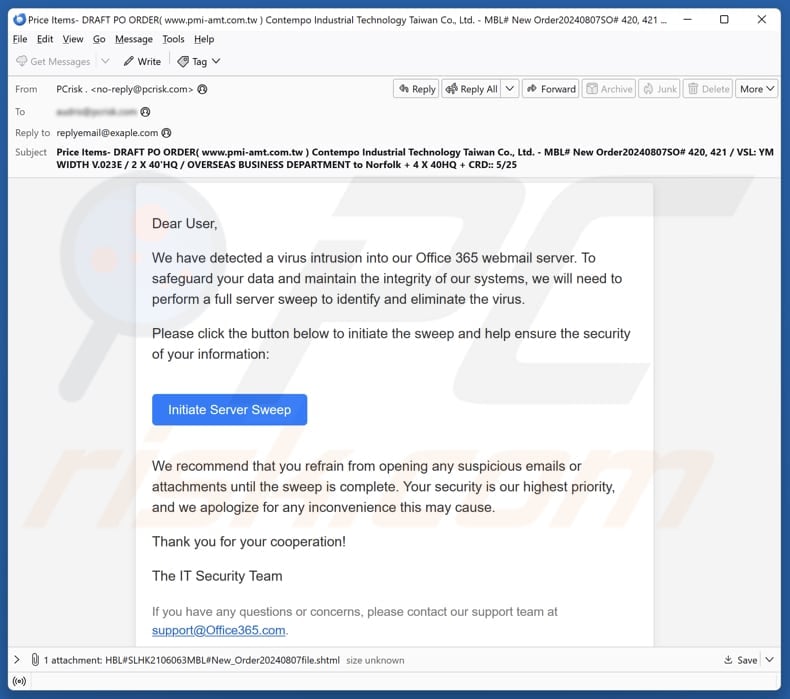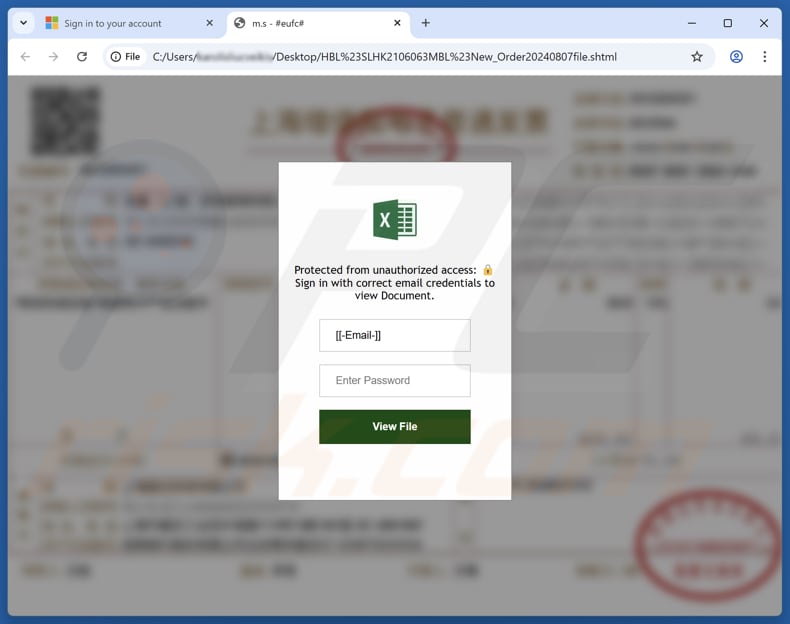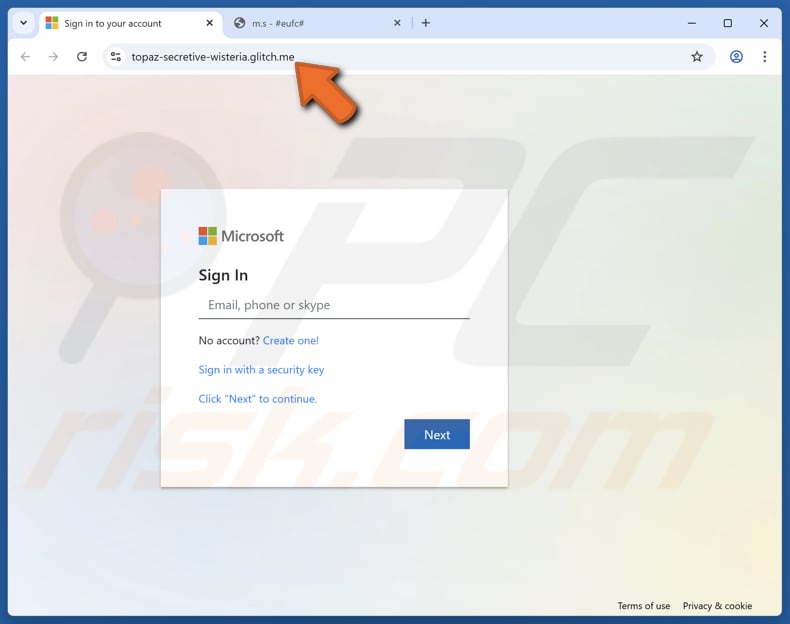How to spot scams like "Virus Intrusion Into Our Office 365 Webmail Server Scam"
Phishing/ScamAlso Known As: Virus Intrusion Into Our Office 365 Webmail Server phishing scam
Get free scan and check if your device is infected.
Remove it nowTo use full-featured product, you have to purchase a license for Combo Cleaner. Seven days free trial available. Combo Cleaner is owned and operated by RCS LT, the parent company of PCRisk.com.
What is "Virus Intrusion Into Our Office 365 Webmail Server"?
Our analysis has shown that this scam involves a deceptive email (and its attachment) and a fraudulent website. The scammers behind it use scare tactics to trick recipients into disclosing personal information. Such scams are known as phishing scams. If this or a similar email is received, it should be ignored and deleted.

More about the "Virus Intrusion Into Our Office 365 Webmail Server" scam email
This scam email poses as a message from an IT security team. It claims that a virus has been detected on the recipient's Office 365 webmail server and urges the recipient to click a button to initiate a "server sweep" to remove the threat. The email contains an "Initiate Server Sweep" button/link and an attachment named "HBL#SLHK2106063MBL#New_Order20240807file.shtml" (its name may vary).
The button/link in this email opens a fake Microsoft sign-in site, and the attached file leads to a fake login form. Both are designed to trick users into disclosing personal information (login credentials). Scammers can use stolen login credentials to access the victim's email, social media, or other online accounts.
They may steal personal information, financial data, or contact lists stored within those accounts. They can also impersonate the victim to scam others or spread malware. If the same password is reused across sites, scammers can gain access to even more of the victim's accounts. Overall, it is important to recognize scam emails and never disclose personal information on provided websites.
| Name | Virus Intrusion Into Our Office 365 Webmail Server Scam |
| Threat Type | Phishing, Scam, Social Engineering, Fraud |
| Fake Claim | A virus has been detected on the recipient's Office 365 webmail server |
| Related Domain | topaz-secretive-wisteria.glitch[.]me |
| Detection Names (topaz-secretive-wisteria.glitch[.]me) | Sophos (Spam), Trustwave (Suspicious), Full List Of Detections (VirusTotal) |
| Attached File | HBL#SLHK2106063MBL#New_Order20240807file.shtml |
| Detection Names (Attachment) | Avast (HTML:Phishing-DYA [Phish]), Combo Cleaner (Trojan.GenericKDS.61299951), ESET-NOD32 (HTML/Phishing.Gen), Ikarus (Win32.Outbreak), Varist (HTML/Phish.HKS), Full List Of Detections (VirusTotal) |
| Disguise | Alert from the email service provider. |
| Symptoms | Unauthorized online purchases, changed online account passwords, identity theft, illegal access of the computer. |
| Distribution methods | Deceptive emails, rogue online pop-up ads, search engine poisoning techniques, misspelled domains. |
| Damage | Loss of sensitive private information, monetary loss, identity theft. |
| Malware Removal (Windows) |
To eliminate possible malware infections, scan your computer with legitimate antivirus software. Our security researchers recommend using Combo Cleaner. Download Combo CleanerTo use full-featured product, you have to purchase a license for Combo Cleaner. 7 days free trial available. Combo Cleaner is owned and operated by RCS LT, the parent company of PCRisk.com. |
Similar scam emails in general
Scam emails of this type often pretend to be urgent/important messages from legitimate organizations or other entities to trick recipients into taking immediate action. They usually contain links or attachments designed to steal personal information (e.g., credit card details or login credentials) or even deliver malware.
Here are some examples of similar scam emails: "Mail Service 2025", "Webmail System Maintenance", and "Account Password Is Old".
How do spam campaigns infect computers?
Threat actors commonly deliver malware by attaching malicious files to their emails. These files might look like regular documents, compressed folders, or programs, but opening them (or taking additional steps, like enabling macros in documents) often leads to malware execution.
These emails may also direct users to fake or unsafe websites that prompt them to download harmful software. Sometimes, the malware downloads automatically when the site is accessed, even without the user clicking anything.
How to avoid installation of malware?
Be cautious with emails or messages that seem strange, especially if they come from unknown senders or contain unexpected links or attachments. Avoid using pirated programs or tools that claim to bypass software protections, as they often contain hidden malware. Regularly update your system and applications.
Only download files and software from trusted websites or app stores. Do not interact with ads, pop-ups, or buttons on suspicious websites, and never allow those sites to send you notifications. A good antivirus program can also help to avoid threats.
If you have already opened malicious attachments, we recommend running a scan with Combo Cleaner Antivirus for Windows to automatically eliminate infiltrated malware.
Text presented in the "Virus Intrusion Into Our Office 365 Webmail Server" email letter:
Subject: Price Items- DRAFT PO ORDER( www.pmi-amt.com.tw ) Contempo Industrial Technology Taiwan Co., Ltd. - MBL# New Order20240807SO# 420, 421 / VSL: YM WIDTH V.023E / 2 X 40'HQ / OVERSEAS BUSINESS DEPARTMENT to Norfolk + 4 X 40HQ + CRD:: 5/25
Dear User,
We have detected a virus intrusion into our Office 365 webmail server. To safeguard your data and maintain the integrity of our systems, we will need to perform a full server sweep to identify and eliminate the virus.
Please click the button below to initiate the sweep and help ensure the security of your information:
Initiate Server SweepWe recommend that you refrain from opening any suspicious emails or attachments until the sweep is complete. Your security is our highest priority, and we apologize for any inconvenience this may cause.
Thank you for your cooperation!
The IT Security Team
Threat actors commonly deliver malware by attaching malicious files to their emails. These files might look like regular documents, compressed folders, or programs, but opening them (or taking additional steps, like enabling macros in documents) often leads to malware execution.These emails may also direct users to fake or unsafe websites that prompt them to download harmful software. Sometimes, the malware begins downloading automatically when the site is accessed, even without the user clicking anything.
If you have any questions or concerns, please contact our support team at support@Office365.com.© 2023 Company Name. All rights reserved.
Attachment ("HBL#SLHK2106063MBL#New_Order20240807file.shtml"):

Website included in this scam:

Instant automatic malware removal:
Manual threat removal might be a lengthy and complicated process that requires advanced IT skills. Combo Cleaner is a professional automatic malware removal tool that is recommended to get rid of malware. Download it by clicking the button below:
DOWNLOAD Combo CleanerBy downloading any software listed on this website you agree to our Privacy Policy and Terms of Use. To use full-featured product, you have to purchase a license for Combo Cleaner. 7 days free trial available. Combo Cleaner is owned and operated by RCS LT, the parent company of PCRisk.com.
Quick menu:
- What is Virus Intrusion Into Our Office 365 Webmail Server phishing scam?
- Types of malicious emails.
- How to spot a malicious email?
- What to do if you fell for an email scam?
Types of malicious emails:
![]() Phishing Emails
Phishing Emails
Most commonly, cybercriminals use deceptive emails to trick Internet users into giving away their sensitive private information, for example, login information for various online services, email accounts, or online banking information.
Such attacks are called phishing. In a phishing attack, cybercriminals usually send an email message with some popular service logo (for example, Microsoft, DHL, Amazon, Netflix), create urgency (wrong shipping address, expired password, etc.), and place a link which they hope their potential victims will click on.
After clicking the link presented in such email message, victims are redirected to a fake website that looks identical or extremely similar to the original one. Victims are then asked to enter their password, credit card details, or some other information that gets stolen by cybercriminals.
![]() Emails with Malicious Attachments
Emails with Malicious Attachments
Another popular attack vector is email spam with malicious attachments that infect users' computers with malware. Malicious attachments usually carry trojans that are capable of stealing passwords, banking information, and other sensitive information.
In such attacks, cybercriminals' main goal is to trick their potential victims into opening an infected email attachment. To achieve this goal, email messages usually talk about recently received invoices, faxes, or voice messages.
If a potential victim falls for the lure and opens the attachment, their computers get infected, and cybercriminals can collect a lot of sensitive information.
While it's a more complicated method to steal personal information (spam filters and antivirus programs usually detect such attempts), if successful, cybercriminals can get a much wider array of data and can collect information for a long period of time.
![]() Sextortion Emails
Sextortion Emails
This is a type of phishing. In this case, users receive an email claiming that a cybercriminal could access the webcam of the potential victim and has a video recording of one's masturbation.
To get rid of the video, victims are asked to pay a ransom (usually using Bitcoin or another cryptocurrency). Nevertheless, all of these claims are false - users who receive such emails should ignore and delete them.
How to spot a malicious email?
While cyber criminals try to make their lure emails look trustworthy, here are some things that you should look for when trying to spot a phishing email:
- Check the sender's ("from") email address: Hover your mouse over the "from" address and check if it's legitimate. For example, if you received an email from Microsoft, be sure to check if the email address is @microsoft.com and not something suspicious like @m1crosoft.com, @microsfot.com, @account-security-noreply.com, etc.
- Check for generic greetings: If the greeting in the email is "Dear user", "Dear @youremail.com", "Dear valued customer", this should raise suspiciousness. Most commonly, companies call you by your name. Lack of this information could signal a phishing attempt.
- Check the links in the email: Hover your mouse over the link presented in the email, if the link that appears seems suspicious, don't click it. For example, if you received an email from Microsoft and the link in the email shows that it will go to firebasestorage.googleapis.com/v0... you shouldn't trust it. It's best not to click any links in the emails but to visit the company website that sent you the email in the first place.
- Don't blindly trust email attachments: Most commonly, legitimate companies will ask you to log in to their website and to view any documents there; if you received an email with an attachment, it's a good idea to scan it with an antivirus application. Infected email attachments are a common attack vector used by cybercriminals.
To minimise the risk of opening phishing and malicious emails we recommend using Combo Cleaner Antivirus for Windows.
Example of a spam email:

What to do if you fell for an email scam?
- If you clicked on a link in a phishing email and entered your password - be sure to change your password as soon as possible. Usually, cybercriminals collect stolen credentials and then sell them to other groups that use them for malicious purposes. If you change your password in a timely manner, there's a chance that criminals won't have enough time to do any damage.
- If you entered your credit card information - contact your bank as soon as possible and explain the situation. There's a good chance that you will need to cancel your compromised credit card and get a new one.
- If you see any signs of identity theft - you should immediately contact the Federal Trade Commission. This institution will collect information about your situation and create a personal recovery plan.
- If you opened a malicious attachment - your computer is probably infected, you should scan it with a reputable antivirus application. For this purpose, we recommend using Combo Cleaner Antivirus for Windows.
- Help other Internet users - report phishing emails to Anti-Phishing Working Group, FBI’s Internet Crime Complaint Center, National Fraud Information Center and U.S. Department of Justice.
Frequently Asked Questions (FAQ)
Why did I receive this email?
Usually, scam emails are not aimed at anyone in particular, they often contain generic messages. If someone receives such an email, it likely means their address was found through a data leak, a fake website, or another source.
I have provided my personal information when tricked by this email, what should I do?
If login credentials were entered, it is important to change the passwords for those accounts right away. It is also recommended to update passwords for any other accounts that share the same or similar login information to prevent hijacking.
I have downloaded and opened a file attached to this email, is my computer infected?
The file attached to this email does not contain malware. However, opening a malicious executable file can cause system infection. Files like PDFs and Office documents are usually safer, but they can plant malware if users enable macros.
I have read the email but did not open the attachment, is my computer infected?
Simply viewing an email without clicking on links or opening attachments does not pose a risk to your computer. Most threats require some form of user interaction to activate.
Will Combo Cleaner remove malware infections that were present in email attachment?
Combo Cleaner can detect and remove most known malware, but since some threats can be deeply hidden, performing a full system scan is crucial for complete removal.
Share:

Tomas Meskauskas
Expert security researcher, professional malware analyst
I am passionate about computer security and technology. I have an experience of over 10 years working in various companies related to computer technical issue solving and Internet security. I have been working as an author and editor for pcrisk.com since 2010. Follow me on Twitter and LinkedIn to stay informed about the latest online security threats.
PCrisk security portal is brought by a company RCS LT.
Joined forces of security researchers help educate computer users about the latest online security threats. More information about the company RCS LT.
Our malware removal guides are free. However, if you want to support us you can send us a donation.
DonatePCrisk security portal is brought by a company RCS LT.
Joined forces of security researchers help educate computer users about the latest online security threats. More information about the company RCS LT.
Our malware removal guides are free. However, if you want to support us you can send us a donation.
Donate
▼ Show Discussion